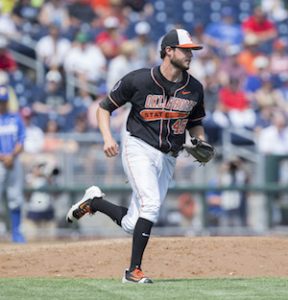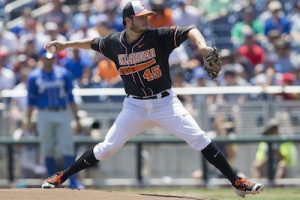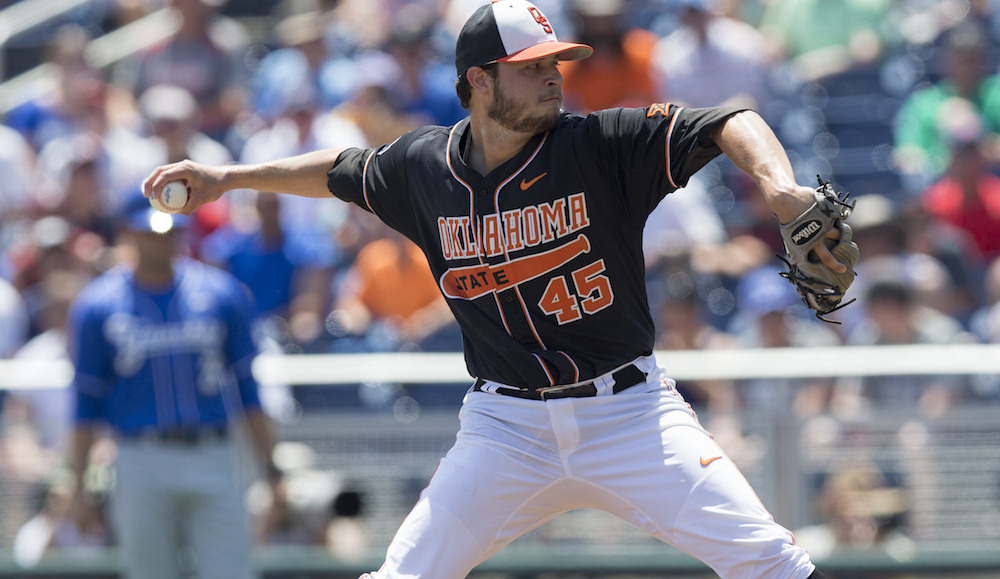Feature Photo: Thomas Hatch, RHP, Cubs (Pictured with Oklahoma
State University at 2016 CWS) Photo by Bruce Waterfield/OSU Athletics
 Thomas Hatch (RHP, Cubs) was on the Oklahoma State Cowboys’ team bus headed to a practice on June 10, 2016, a Friday, before a super regional game in South Carolina and his interest in the MLB draft had dropped like a Clayton Kershaw (LHP, Dodgers) curveball.
Thomas Hatch (RHP, Cubs) was on the Oklahoma State Cowboys’ team bus headed to a practice on June 10, 2016, a Friday, before a super regional game in South Carolina and his interest in the MLB draft had dropped like a Clayton Kershaw (LHP, Dodgers) curveball.
The first two rounds passed without his name being called, and Hatch stopped paying attention because he had a College World Series game to win for the Cowboys.
His coach at OSU, Josh Holliday, had done a good job of helping his team focus on the game at hand. He had to because a large portion of his players were expected to be taken at some point that weekend.

Thomas Hatch, RHP, Cubs (Pictured vs. Abilene Christian Wildcats, Friday, March 11, 2016, Allie P. Reynolds Stadium, Stillwater, OK). Photo by Bruce Waterfield/OSU Athletics
When Hatch did find out the Chicago Cubs had drafted him (in the third round, #104 overall), it was because a teammate delivered the news. “I remember thinking, ‘That’s not a bad team to be drafted by.’ And that was before they won the whole thing,” Hatch said in a recent interview.
His excitement did not interfere with his performance in the College World Series, however. His Cowboys won their super regional against South Carolina and advanced to the College World Series for the first time since 1999.
“That was really exciting, and there were definitely a lot of butterflies,” Hatch said. “Especially pitching in the opening game. It’s unlike anything I have ever done. We get big crowds in the Big 12, but that was multiplied by four [at the CWS].”
Those big crowds might serve as a foretaste of what is to come for Hatch when eventually he pitches at Wrigley Field. Already, Hatch has had some introduction to that fan base. “Everywhere I go, there’s a [Cubs] fan club. It doesn’t matter where I am. I didn’t expect that.,” he said.
Hatch’s full introduction to the Cubs has been delayed because of a precautionary decision to limit his work after he joined the club last summer. That was the team’s choice because of the heavy workload he endured in his final college season, and the fact that a sprained ulnar collateral ligament kept him out for all of 2015.
“I would have liked to have pitched, but they had my health in mind, and that’s the No. 1 priority,” Hatch said
His former coach at OSU saw holding him out as the right approach as well. “They wisely shut him down and gave him a chance to reset the mechanism.” Holliday said.
Though the injury sidelined him for more than a year, Hatch and his former coach believe it has helped him in the long run, and the Cubs benefited from being able to grab the starter later in the draft because of his injury history.
“He was an absolute steal in the third round,” Holliday said. Hatch’s former coach believes the adjustments he made after missing the 2015 season have taken him to a new level.

Thomas Hatch, RHP, Cubs (Pictured playing in 2016 College World Series, vs UC-Santa Barbara Gauchos, Game 1, 6/18/16). Photo by Bruce Waterfield/OSU Athletics
“He went from a guy with some stuff to a guy with skill. You know, from just a good arm to a really good pitcher,” Holliday said.
The OSU coach cites a shift in Hatch’s arm slot that he said reminds him of Tim Hudson (RHP, A’s, Braves, Giants, 1999-2015). The new 3/4 ’s arm slot, a change from a higher arm slot following the elbow injury that sidelined him in 2015, meant that Hatch needed to stop throwing his curveball and take up a slider instead.
This is a change that Hatch has found beneficial in multiple ways.
“I had trouble getting on top of the curveball [with the new arm slot], and I was never very consistent with the curve. I never really got the feel for that pitch,” Hatch said.
The change to a slider has also taken some of the strain off of his elbow, Hatch said, and it has added velocity, and unexpected benefit of the new arm slot, which was intended to reduce strain on his elbow.
Holliday said he has seen Hatch’s velocity creep up a few ticks, from where he usually sits at 92-to-94 mph up to 95-to-96 mph.
But it’s not just about increased velocity. Paired with his heater, Hatch throws a sinker and a slider that both come out of the same window.
“His stuff went from very good to nasty. The ball darts down and away on a lefty, and in on the hands on a righty. He makes the plate pretty active from both sides,” Holliday said.
The change in his arm slot made him “an uncomfortable at-bat,” according to Holliday. “There were a lot of good teams that couldn’t figure him out [last season].”
Following his selection by the Cubs last year, Hatch wanted to pitch, he said, but he knew his health was of greater importance. So, while he threw just a handful of bullpen sessions after joining the organization, the Cubs still took care to get him acclimated in other ways.
“I spent a lot of time getting a feel for the organization, learning what minor league life is like,” Hatch said.
This meant spending a lot of time at the Cubs’ facilities in Mesa, Ariz., working out and preparing almost like he would during the offseason. Near the end of the minor league season, Hatch was sent to spend time with the Cubs’ Class A affiliate in South Bend, IN. that plays in the Midwest League.

Thomas Hatch, RHP, Cubs (Pictured playing in 2016 College World Series, vs UC-Santa Barbara Gauchos, Game 1, 6/18/16). Photo by Bruce Waterfield/OSU Athletics
“I went off to South Bend and hung out with them for a week before the season ended, so I could get a feel for what life is like outside of Arizona,” Hatch said.
This last week of the season gave Hatch the chance to meet some future teammates and experience both games at home in South Bend and a road trip to play the West Michigan Whitecaps, the Detroit Tigers’ Class A affiliate near Grand Rapids, MI.
As Hatch looks to the upcoming season, he is not worried about which rung he will start on in the organizational ladder.
“I know they have my future in mind, and they know what is best for me, so I’m not necessarily worried about where I end up,” he said.
“I just know that wherever it is, I’ll be prepared.”
In Hatch’s first real experience in the minor leagues, he will be ready to showcase his fastball, sinker, slider mix that stands to eventually pave his way into a Cubs’ rotation that will be in significant need of restocking after 2017, as John Lackey (RHP, Cubs) and possibly Jake Arrieta (RHP, Cubs) leave the rotation for free agency. The development timeline for Hatch could put him in the major leagues as early as 2019 realistically, right when the Cubs might need the arms the most. Hatch was the first of nine pitchers the Cubs took in last year’s draft, and he could also stand to be the first of the 2016 draft class to reach the majors.
The right-hander pounds the lower part of the strike zone to force a lot of ground balls — the kind of contact that the elite infield defense in Chicago will gobble up — and he gets movement on his pitches that make for tough at-bats for hitters on both sides of the plate.
Hatch will have to show that the time spent resting and preparing, along with the new arm slot, will keep his elbow healthy. If he does, the Cubs will have another reason to be confident that their young core of positional talent will be complemented with sturdy pitching.


